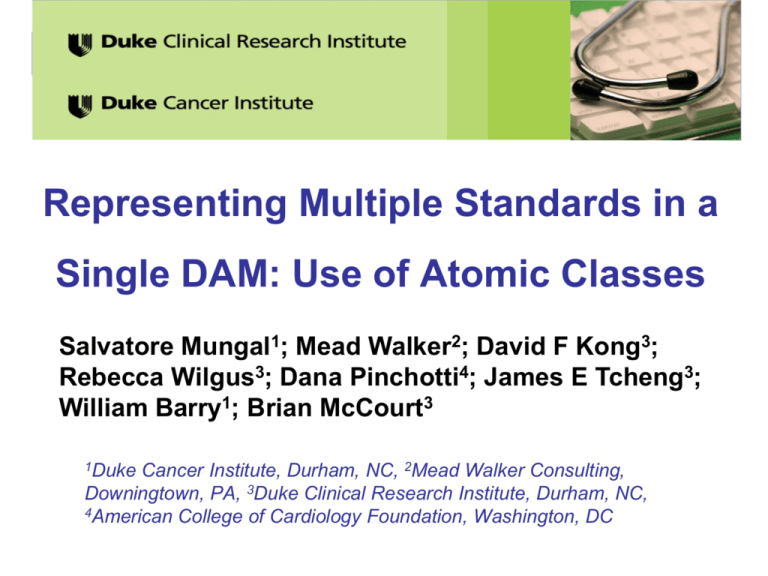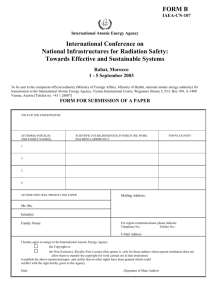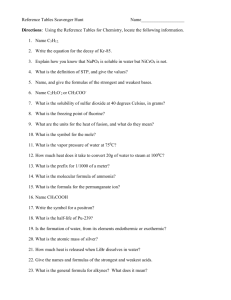Representing Multiple Standards in a Single DAM: Use of Atomic
advertisement

Representing Multiple Standards in a Single DAM: Use of Atomic Classes Salvatore Mungal1; Mead Walker2; David F Kong3; Rebecca Wilgus3; Dana Pinchotti4; James E Tcheng3; William Barry1; Brian McCourt3 1Duke Cancer Institute, Durham, NC, 2Mead Walker Consulting, Downingtown, PA, 3Duke Clinical Research Institute, Durham, NC, 4American College of Cardiology Foundation, Washington, DC Agenda • Aim: To create a Cardiology DAM • Background – Movement towards Interoperability – The issues • Atomic class resolution • Results • Conclusion Background • The National Cardiovascular Research Infrastructure team and many stakeholders created a consensusbased, authoritative and harmonized set of clinical data standards to meet the diverse requirements necessary to streamline collection and secondary reporting of health care data. • Data element (DE) components included names, definitions, permissible value names and definitions, data types, citations, links to the source vocabulary and inter-DE relationships and represented the smallest meaningful unit of instantiated data. • DAM creation – From these DEs, a multi-disciplinary team created a UML-based representation following NCI’s modeling guidelines to facilitate ISO 11179 compliant metadata publication. Background • Overcoming methodological and tooling challenges, we formulated a UML-based metadata model allowing multiple representations (such as HL7 RIM and the CDISC Study Data Tabulation Model (STDM)) within in a single Domain Analysis Model (DAM) and subsequent dissemination via an ISO 11179 compliant metadata repository. Interoperability Overlapping perspectives on nomenclature and formalisms toward interoperability in healthcare. • Use of ISO 11179 metadata standard via NCI’s caDSR (ontologies and terminologies) with the addition of CDISC and HL-7 standards lay the foundation for interoperability in healthcare. Issues • The typical ad hoc mapping of disparate document-based standards and controlled terminology are insufficient for representing the complex relationships such that barriers to reuse are greatly reduced. • The dynamic, multidimensional and interrelated nature of information consumed and generated during the patient care process dictates that data elements must be able to be used, unconstrained, in each scenario. • Initial attempts to represent a data element in a common model of aggregated contexts were informative; however, modeling every instantiation or permutation led to a very high level of complexity and redundancy. We observed a large number of attributes (DEs) were duplicated - as many as 19 times with over 1800 CDEs created. • Maintenance of the UML DAM was intractable. • Many other approaches such as the abstraction, inheritance and instance classifiers failed to satisfy functional requirements of the model. Issues • Illustration of the CABGIndications and CABGComplications classes associated to the CABG class showing the acuteMI attributes before use of Atomic classes. Atomic Class Resolution • Conversion to the Acute Myocardial Infarction atomic class. Note the Indication and Complication associations to the CABG class. Results • The CV DAM R2 yielded approximately 349 CDEs. • The DEs are organized into approximately 165 atomic classes within 18 parent classes and 4 sub-domains of cardiology. • By leveraging atomic classes, our data model with 349 unique DEs was dispersed and replicated to over 1800 attributes in the original model but condenses to a more parsimonious and generalizable model with only 815 elements (from the replicated 349 CDEs). Conclusion • Modeling different representations of harmonized vocabulary-based DEs in a single DAM serving disparate groups became intractable, but the use of atomic classes in a CDELibrary curtails this. • The use of atomic classes reduces maintenance efforts because updates to any DEs are cascaded to all uses in the model. • Using the atomic classes in the CDELibrary, it is relatively easy to formulate a different representation through standard modeling methods. This, plus the publication in a public metadata repository, offers a readily consumable, common source for data specifications serving diverse stakeholders. • This DAM with use of atomic classes in a CDELibrary will facilitate future semantic and syntactic interoperability across healthcare and secondary reporting initiatives. Thank you!






